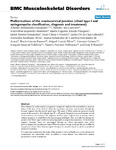Malformations of the craniocervical junction (chiari type i and syringomyelia: classification, diagnosis and treatment)

Use este enlace para citar
http://hdl.handle.net/2183/15871Coleccións
- Investigación (FFISIO) [481]
Metadatos
Mostrar o rexistro completo do ítemTítulo
Malformations of the craniocervical junction (chiari type i and syringomyelia: classification, diagnosis and treatment)Autor(es)
Data
2009-12-17Cita bibliográfica
Avellaneda Fernández A, Isla Guerrero A, Izquierdo martínez M, et al. Malformations of the craniocervical junction (chiari type i and syringomyelia: classification, diagnosis and treatment). BMC Muskusloskeletal Disord. 2009;10:S1
Resumo
[Abstract] Chiari disease (or malformation) is in general a congenital condition characterized by an anatomic defect of the base of the skull, in which the cerebellum and brain stem herniate through the foramen magnum into the cervical spinal canal. The onset of Chiari syndrome symptoms usually occurs in the second or third decade (age 25 to 45 years). Symptoms may vary between periods of exacerbation and remission. The diagnosis of Chiari type I malformation in patients with or without symptoms is established with neuroimaging techniques. The most effective therapy for patients with Chiari type I malformation/ syringomyelia is surgical decompression of the foramen magnum, however there are non-surgical therapy to relieve neurophatic pain: either pharmacological and non-pharmacological. Pharmacological therapy use drugs that act on different components of pain. Non-pharmacological therapies are primarly based on spinal or peripheral electrical stimulation. It is important to determine the needs of the patients in terms of health-care, social, educational, occupational, and relationship issues, in addition to those derived from information aspects, particularly at onset of symptoms. Currently, there is no consensus among the specialists regarding the etiology of the disease or how to approach, monitor, follow-up, and treat the condition. It is necessary that the physicians involved in the care of people with this condition comprehensively approach the management and follow-up of the patients, and that they organize interdisciplinary teams including all the professionals that can help to increase the quality of life of patients.
Versión do editor
Dereitos
Creative Commons Licence Reconocimiento 4.0 Internacional






